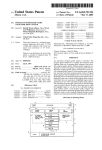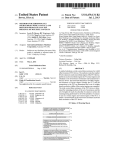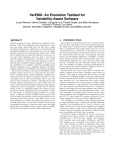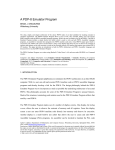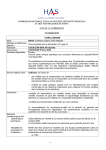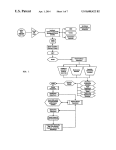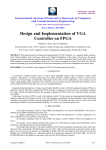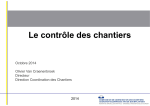Download Automatic generation of programmable logic device architectures
Transcript
US006631510B1 (12) United States Patent (10) Patent N0.: (45) Date of Patent: Betz et al. (54) AUTOMATIC GENERATION OF US 6,631,510 B1 Oct. 7, 2003 G. LemieuX et al., “A Detailed Router FOr Allocating Wire Segments In FPGAs,” ACM/SIGDA Physical Design Work shop, 1993, p. 215—226. PROGRAMMABLE LOGIC DEVICE ARCHITECTURES D. Cronquist et al., “Emerald—An Architecture—Driven Tool Compiler for FPGAs”, ACM Symp. on FPGAs, 1996, (75) Inventors: Vaughn Betz, Toronto (CA); Jonathan Rose, Toronto (CA) pp. 144—150. P. ChoW et al., The Design Of An SRAM—Based Field (73) Assignee: Altera Toronto Co., Nova Scotia (CA) Programmable Gate Array, Part I: Architecture, Jun. 1999, pp. 191—197. (*) Notice: Subject to any disclaimer, the term of this patent is extended or adjusted under 35 Ebeling et al., “Placement and Routhing Tools For The Triptych FPGA,” IEEE Trans. on VLSI, Dec. 1995, pp. U.S.C. 154(b) by 0 days. 473—482. G. LemieuX et al., “On TWo—Step Routing For FPGAs”, ACM Symp. on Physical Design, 1997, pp. 60—66. (21) Appl. No.: 09/429,013 (22) Filed: H. Hseih et al., “ThirdiGeneration Architecture Boosts Oct. 29, 1999 Speed And Density of Field—Programmable Gate Arrays”, (51) Int. Cl.7 .............................................. .. G06F 17/50 (52) US. Cl. ........................... .. 716/16; 326/39; 326/41; (58) Field of Search ............................ .. 716/2, 4, 6, 11, CICC, 1990, pp. 33.2.1—31.27. M. Khellah et al., “Minimizing Interconnection Delays In Array—Based FPGAs,” CICC, 1194, pp. 181—184. 716/2; 716/4; 716/6; 716/12; 716/14 * cited by examiner 716/12, 14, 16; 326/39, 41 (56) Primary Examiner—Vuthe Siek Assistant Examiner—Thuan Do References Cited (74) Attorney, Agent, or Firm—Fish & Neave; Garry J. U.S. PATENT DOCUMENTS 5,197,016 A 5,550,839 A Tuma (57) 3/1993 Sugimoto et al. ............ .. 716/8 * 8/1996 Buch et al. ..... .. ABSTRACT .. 716/16 5,553,002 A 9/1996 Dangelo et al. .. 716/11 The invention consists of a neW component called the 5,594,657 A 1/1997 Cantone et al. 716/16 Architecture Generation Engine added to the CAD system for implementing circuits into PLD architectures and for 5,687,325 A 5,801,546 A 5,825,202 A 11/1997 Chang .. ... ... .. . . . .. 9/1998 Pierce et al. 716/17 326/41 5,907,248 A 5/1999 Bauer et al. 5,942,913 8/1999 Young et al. 2/2003 Guheen et al. ............. .. 705/14 A 6,519,571 B1 * evaluating performances of different architectures. The Architecture Generation Engine converts a high-level, easily speci?ed description of a PLD architecture into the highly 326/41 10/1998 Tavana et al. . 326/41 ..... detailed, complete PLD architecture database required by . . . .. 326/41 the internals of the CAD toolset in order to map a circuit netlist into the PLD. The Architecture Generation Engine also enables the performance evaluation of a Wide variety of PLD architectures for given benchmark circuits. OTHER PUBLICATIONS S. BroWn et al., “A Detailed Router For FIeld—Program mable Gate Arrays”, IEEE Trans. on CAD, May 1992, pp. 26 Claims, 12 Drawing Sheets 620—628. ARCHITECTURE DESCRIPTION FILE ARCHITECTURE GENERATION ENGINE PARSE FILE STEP 1 CHECK FOR FUNCTIONAL AND SEMANTIC ERRORS an STEP 2 ; ENUMERATE ALL BASIC ELEMENTS STEP 3 DESIGN ALL BASIC STEP 4 LE ENTS REPLICATE VARIANTS OF THE BA C ELEMENTS & STITCH TILES TOGETHER STEP 5 I + EVALUATE OVERALL PLD AREA, GENERATE STEP 6 TIMING MODELS FULLY DETAILED PLD TO PLD CAD TOOLS (E G. ARCHITECTURE (E G ROUTING RESOURCE GRAPH, TIMING GRAPH TECHNOLOGY MAPPING. LEGAL SLOT LIST) PLACE AND ROUTE, ARCHITECTURE EVALUATION) TYPICAL FLOW DIAGRAM FOR THE ARCHITECTURE GENERATION ENGINE U.S. Patent 0a. 7, 2003 Sheet 1 0f 12 US 6,631,510 B1 xzo0t>3w .wI F U.S. Patent 0a. 7, 2003 Sheet 2 0f 12 US 6,631,510 B1 BENCHMARK CIRCUITS (EXAMPLE APPLICATION CIRCUITS) V PLD ARCHITECTURE DESCRIPTION COMPUTER-AIDED DESIGN SYSTEM TARGETTING PLD ARCHITECTURE OF INTEREST EVALUATE QUALITY OF BENCHMARK CIRCUIT IMPLEMENTATIONS IN PLD ARCHITECTURE TYPICAL PLD ARCHITECTURE EVALUATION FLOW DIAGRAM FIG. 2 U.S. Patent Oct. 7,2003 Sheet 3 0f 12 US 6,631,510 B1 BENCHMARK CIRCUITIS) HIGH-LEVEL , ARCHITECTURE DESCRIPTION I _____ _ _ I; _____ _ _I I SYSTHESIS AND LOGIC I PLD , OPTIMIZATION I CAD I V l TECHNOLOGY I I TOOLS I MAPPING I I ARCHITECTURE GENERATION ENGINE I I T I L. _ _ ‘ I PLACE AND ROUTE l I _ ‘ _ _ _ i_ _ _ _ _ _. _ J EVALUATE PLD PERFORMANCE ADJUST PLD PARAMETERS YES CHANGE PLD PARAMETERS? PLD ARCHITECTURE EVALUATION COMPLETED CAD FLOW DIAGRAM PROPOSED BY THIS INVENTION FOR PLD ARCHITECTURE GENERATION AND EVALUATION FIG. 3 U.S. Patent 0a. 7, 2003 Sheet 4 0f 12 US 6,631,510 B1 CONNECTION BLOCK POPULATION: 100% 80% 60% 40% POSSIBLE CONNECTION-BLOCK POPULATION VALUES FOR LENGTH 5 WIRE SEGMENTS. FIG. 4 U.S. Patent 0a. 7, 2003 io_rat 2 chan_width_io 1 Sheet 5 0f 12 US 6,631,510 B1 # 2 l0 pads per row or column # All channels the same width. chan_width_x uniform 1 chan_width_y uniform 1 # 4-input LUT. LUT inputs first, then output, then clock. inpin class: 0 bottom inpin class: 0 left # Equivalence class 0 is LUT inputs inpin class: 0 top inpin class: 0 right outpin class: 1 bottom inpin class: 2 global top # Output. Not equivalent to anything. # Clock. switch_block_type subset # Called disjoint switch block by some. Fc_type fractional # Fc values are relative to W Fc_output 1 Fc_input 1 Fc_pad 1 # Definitions of different types of routing wires. segment frequency: 0.2 length: 1wire_switch: 0 opin__switch: 1 Frac_cb: 1.\ Frac_sb: 1. Rmetal: 4.16Cmetal: 81e-15 segment frequency: 0.4 length: 2 wire_switch: 2 opin_switch: 2\ Frac_cb: 1. Frac_ab: 1Rmetal: 4.16 Cmetal: 8le-15 segment frequency: 0.4 length: 4wire_switch: 2opin_switch: 2\ Frac_cb: 1. Frac_sb: 1Rmetal: 4.16Cmetal: 81e-15 # Definitions of different types of routing switches. # Pass transistor switch. switch 0 buffered: no R: 196.728 Cin: 20.574e-15 Cout: 20.574e-15 Tdel: 0 # Logic block output buffer used to drive pass transistor switched wires. switch 1 buffered: yes R: 393.47 Cin: 7.512e-15 Cout: 20.574e-15 Tdel: 524e-12 # Switch used as a tri-state buffer within the routing, and also as the # output buffer used to drive tri-state buffer switched wires. switch 2 buffered: yes R: 786.9 Cin: 7.512e-15 Cout: 10.762e-15 Tdel: 456e-12 # Used only by the area model. R_minW_nmos 1967 R__minW_pmos 3738 # Timing info below. See manual for details. C_ipin_cblock ‘1.512e-15 T_ipin_cblock 1.5e-9 T_ipad 478e-12 # clk_to__Q + 2:1 mux T_opad 295e-12 # Tsetup T_sblk_opin_to_sblk_ipin o. T_clb_ipin_to_sblk_ipin o. F|G_ 5 . Examplearchltecture descrlpilon ?le T_sblk_opin_to_clb_opin 0. subblocks_per_clb 1 subblock_lut_size 4 T_subblock T_comb: 546e-12 T_seq_in: 845e-12 T_seq_out: 478e-12 U.S. Patent 061. 7, 2003 WIRE Sheet 6 6f 12 US 6,631,510 B1 WIRE MODELLING FPGA ROUTING ARCHITECTURE AS A DIRECTED GRAPH FIG. 6 U.S. Patent Oct. 7, 2003 Sheet 7 0f 12 US 6,631,510 B1 ARCHITECTURE DESCRIPTION FILE ARCHITECTURE GENERATION ENGINE \ PARSE FILE STEP 1 V CHECKFOR FUNCTIONAL AND SEMANTIC ERRORS STEP 2 \ ENUMERATE ALL BASIC ELEMENTS STEP 3 V DESIGN ALL BASIC ELEMENTS STEP 4 \ REPLICATE vARIANTS OF THE BASIC STEP 5 ELEMENTS & STITCH TILES TOGETHER \ EVALUATE OvERALL PLD AREA, GENERATE TIMING MODELS STEP 6 FULLY DETAILED PLD ARCHITECTURE (E.G. ROUTING RESOURCE GRAPH, TIMING GRAPH LEGAL SLOT LIST) TO PLD CAD TOOLS (E.G. TECHNOLOGY MAPPING, PLACE AND ROUTE, ARCHITECTURE EVALUATION) TYPICAL FLOW DIAGRAM FOR THE ARCHITECTURE GENERATION ENGINE FIG. 7 U.S. Patent 0a. 7, 2003 Sheet 8 0f 12 US 6,631,510 B1 ROUTING WIRE ' \ ROUTING SWITCH FIG. 8(a) EXAMPLE CONNECTION BLOCK PATTERN: PATHOLOGICALLY BAD NETS STARTING AT OUT2 CAN ONLY REACH IN2, NETS STARTING AT OUT1 CAN ONLY REACH IN1. FIG. 8(b) EXAMPLE CONNECTION BLOCK PATTERN: GOOD. NETS STARTING AT EITHER OUTPUT CAN REACH EITHER INPUT; VASTLY IMPROVED ROUTABILITY U.S. Patent 0a. 7, 2003 Sheet 9 0f 12 US 6,631,510 B1 PROGRAMMABLE SWITCH l \ WIRE SEGMENT FIG. 9(a) ARCHITECTURE SPECIFICATION: DISJOINT SWITCH BLOCK SEGMENT "START POINTS" /\ \ E/ FIG. 9(0) ARCHITECTURE SPECIFICATION: SEGMENTATION DISTRIBUTION. EACH CHANNEL CONTAINS 3 WIRES OF LENGTH THREE. U.S. Patent 0a. 7, 2003 Sheet 10 0f 12 US 6,631,510 B1 z“g2b0a:c5mn; 295t986Mo:2 _.Jkz6w/Eomw GI2 U.S. Patent 0a. 7, 2003 . .40 Sheet 12 0f 12 4/ US 6,631,510 B1 A P. w“.wE 2m39;5 US 6,631,510 B1 1 2 AUTOMATIC GENERATION OF PROGRAMMABLE LOGIC DEVICE ARCHITECTURES HoWever, in order to implement circuits in a PLD archi tecture of interest, the PLD designer requires a method of describing the PLD architecture to the CAD tool set. There are tWo basic components of a PLD architecture: the routing architecture Which describes the routing resources or the This invention relates generally to Programmable Logic programmable interconnect netWork; and the logic (or Devices (PLDs), and more particularly to a method and function) block architecture. Consider ?rst the problem of describing the PLD routing architecture. system for generation and evaluation of architectures for such devices. BACKGROUND OF THE INVENTION To specify a PLD architecture in its entirety, one must 10 Programmable Logic Devices (PLDs) are a Widely used form of integrated circuit due to the ?exibility provided by Wires and logic and I/O blocks can be interconnected by programmable sWitches, and the delay of every program mable sWitch, routing Wire and circuit path through a logic their customiZable nature. In general PLDs include ?eld programmable gate arrays (FPGAs), complex program mable logic devices (CPLDs), simple programmable logic 15 block in the entire PLD. This is an enormous amount of data—typically tens to hundreds of MB in siZe. Accordingly, it is not practical for a PLD architect to specify this data directly for every PLD architecture in Which he or she is interested. The most straightforWard Way of describing a PLD rout ing architecture is to create a directed graph (also called a devices and laser programmable devices. Architecturally, a PLD includes logic blocks and input/output (I/O) blocks Which are connectable through a programmable interconnect structure. Atypical PLD is an integrated circuit chip that, Wholly or in part, consists of an array of one or more logic blocks, I/O routing-resource graph) that fully speci?es all the connec blocks, and a programmable routing or interconnect net Work. The interconnect netWork can be programmed by a user to provide a connection betWeen the logic and I/O blocks to achieve a desired logic function. A PLD can be a 25 standalone device or be embedded in a larger integrated circuit such as ASICs or the like. Exemplary forms of such embedded PLDs are disclosed in US. Pat. No. 5,825,202 and US. Pat. No. 5,687,325. The logic blocks may be comprised of a ?xed logic nection pin is located. This description must specify Which routing Wires, logic blocks and I/O blocks can be intercon nected by programmable sWitches. The description must also specify the delay of every programmable sWitch, inter connect Wire and circuit path through a logic block, in the and is typically the data structure used internally by the routing tool. HoWever, it is not very practical to specify this nect netWorks and programmable functionality. The logic routing-resource graph manually because the routing 35 cuits or to other parts of the chip as in the case of an resource graph for a typical PLD requires an enormous amount of data—typically in the tens to hundreds of mega bytes of memory in siZe. Essentially, this is too loW-level a description for a PLD architect to use conveniently. A more practical approach is to design a basic tile embedded PLD. The 1/0 blocks are typically arranged at the periphery of a chip. A PLD is typically arranged as a regular array of logic (consisting of a single logic block and its associated routing) blocks, each of Which may be identical or may be one of manually, and create a program to automatically replicate and stitch together this tile into a routing-resource graph several different types (such as memory blocks, look-up table based blocks, p-term based blocks etc.). The conduc tors of the programmable interconnect netWork are typically arranged along roWs and columns de?ed by the array of logic blocks, as shoWn schematically in FIG. 1. The architecture of a PLD speci?es the structure of its tions that may be made in the routing of a circuit in the PLD. In essence, this requires the PLD designer to describe Where every sWitch, interconnect Wire, logic and 1/0 block con entire PLD. This is a very general representation of a PLD function or may in turn also have programmable intercon blocks may be ?rer broken doWn into sub-blocks or grouped together as a cluster of logic blocks. These blocks may also include I/O circuits that enable connection to external cir specify Where every sWitch, routing Wire and logic and IO block pin is located One must also specify Which routing describing the entire PLD routing architecture. HoWever, even the manual creation of a basic tile can be too time 45 consuming for most PLD architectures. A typical tile con tains several hundred programmable sWitches and Wires, so it can take hours or days to describe a single tile. logic blocks, I/O blocks and programmable interconnect Furthermore, the hand-crafted tile is severely limited in the netWork. In order to develop a high-quality PLD PLD interconnect or logic block resources that may be architecture, the PLD designer must evaluate the impact and utility of a Wide range of architectural decisions and trade offs. The performance of a PLD is typically judged on the varied—for example, a hand-crafted tile is generally designed for one value of the routing channel Width, W (the number of routing tracks in a channel). In many architecture basis of operational parameters of circuits implemented in the PLD. These operational parameters include speed of experiments, one must vary W in order to see hoW routable a given PLD architecture is, or to determine the minimum circuits implemented in the PLD, semiconductor or silicon area required to implement a given circuit in the PLD, poWer dissipation of the PLD after it has been programmed, 55 circuits (say 95%) to route successfully. With a tile based approach, the PLD designer must hand-craft different tiles for each different value of W required to be tested. A PLD designer Will often Wish to investigate hundreds of different reliability and routing ?exibility. The typical procedure for evaluating different architec tures is shoWn in FIG. 2. A set of benchmark circuits is implemented in each PLD architecture (or architecture variant) of interest, and the operational parameters of the circuits are analyZed. Generally, PLD designers Wish to experiment With as Wide a variety of PLD architectures as possible in order to determine the architecture or class of architectures that best meets the operational parameters of interest. value of W that alloWs some desired faction of application 65 PLD architectures and tens of W values for each of these architectures. The net result is that the PLD designer is required to create thousands or tens of tho of different basic tiles. There has been some prior Work in describing PLD routing at a higher level of abstraction. In [1], BroWn et al developed an FPGA router for use With island-style FPGAs. In order to quickly investigate FPGAs With different num US 6,631,510 B1 4 3 generating a detailed description from the complete PLD bers of routing switches, they localized all the code that architecture, for use by a CAD toolset By interacted reWriting Withthese switchtWo patterns routines, to tWo theroutines, FPGA designer FC() and can target their router (called CGE) to an FPGA With different sWitch pattern. The later SEGA router [2], used the same method to alloW re-targetting to different FPGAs. In the Emerald CAD system [3], an FPGA’s routing is described by means of WireC schernatics—essentially sche matics annotated With C-language like code that describes sWitch patters. The Emerald system can convert these WireC schematics into routing-resource graphs for use by its FPGA BRIEF DESCRIPTION OF THE DRAWINGS These and other features of the preferred embodiments of the invention Will become more apparent in the folloWing detailed description in Which reference is made to the appended draWings Wherein: 10 according to the prior art; router. FIG. 3 is a schematic ?oW diagram of shoWing an architecture generation system according to an embodiment While CGE, SEGA and Emerald all reduce the labour required to specify a PLD architecture, they still require considerable hand-crafting effort. Instead of specifying FIG. 1 is a block diagram of a typical PLD architecture; FIG. 2 is a PLD architecture evaluation ?oW diagram 15 every sWitch in a basic tile of an FPGA, these systems alloW PLD designers to Write softWare code (in either C or WireC) to generate all the sWitches in a basic tile. If the PLD designer Writes suf?ciently general code, it may be possible of the present invention; FIG. 4 is a schematic diagram shoWing the possible connection-block population values for length 5 Wire seg ments; FIG. 5 shoWs an eXample architecture description ?le; FIG. 6 shoWs an hoW an eXample architecture can be to change some interconnect and logic resources, such as the modelled using a directed graph; FIG. 7 shoWs the typical ?oW diagram for the Architecture channel Width W, and have the basic tile adapt properly. HoWever, it is the user’s task to specify this in often non-obvious code. The second portion of a PLD architecture description details each type of function block (logic or 1/0 block) contained in the PLD. Both the interface to the PLD routing of each function block (i.e. a list of the inputs and outputs of the block) and a description of the logic functions that can Generation Engine; FIG. 8(a) shoWs a connection block pattern that is patho logically bad; FIG. 8(b) shoWs a connection block pattern that is good; FIG. 9(a) is an architecture speci?cation for a disjoint be implemented by the function block, must be provided. A sWitch block; FIG. 9(b) is an architecture speci?cation for segmentation concise method for providing this information is crucial to distribution; alloW easy experimentation. As Well, timing and area model information for both the routing and function blocks may be included in the PLD architecture description, to alloW the CAD tools to estimate the speed achieved by the circuits in this architecture, and the layout area consumed by the architecture. FIG. 10 shoWs hoW replicating one channel causes hori Zontal and vertical constraints to con?ict; FIG. 11 shoWs hoW adjusting the segment start points 35 FIG. 12 shoWs the tiled layout used to implement the PLD architecture of FIG. 11 above. Accordingly, there is a need for a method and system that reduces the labour involved in describing a complete PLD architecture and alloWs the easy variation of many intercon nect and logic resource parameters of the architecture. DETAILED DESCRIPTION OF THE PREFERRED EMBODIMENT Preferably, the architecture generation engine converts a concise high-level description of a PLD architecture into the SUMMARY OF THE INVENTION In accordance With this invention there is provided a system for generating a PLD architecture comprising: an Architecture Generation Engine for converting a high level, easily speci?ed description of a PLD architecture alloWs both the horiZontal and vertical constraints to be satis?ed Within a PLD coordinate system; and fully detailed description required by the CAD tools to 45 implement circuits in the PLD and to estimate the perfor mance of the architecture. A preferred implementation of hoW to represent a PLD architecture concisely, and to automatically generate the fully detailed representation of into the highly detailed, complete PLD architecture database; the detailed PLD architecture used by the the architecture is described beloW. Many variations on this CAD toolset to map a circuit netlist into the PLD. In a further embodiment, the Architecture Generation using only a subset of the parameters listed beloW to preferred implementation are possible, hoWever, including Engine also enables the performance evaluation of a Wide variety of PLD architectures for given benchmark circuits. In a further embodiment of the invention, there is pro vided a CAD system for implementing circuits into PLD architectures and for evaluating performances of different describe a PLD, or using a different set of parameters. 55 the Wire length (number of logic blocks spanned), and architectures. In accordance With a further embodiment of the invention, there is provided a method for generating an architecture for the Wire resistance and capacitance, or other delay metric; The various “types” of programmable routing sWitch used a programmable logic device (PLD), the method comprising in the PLD, including Whether each sWitch is a pass the steps of: creating a data ?le de?ning a high-level architecture transistor, tri-state buffer, multiplexer, antifuse, etc.; the delay of the sWitch, (Which may be a ?ll delay model, description of the programmable logic device; creating unique functional elements of the PLD generally matching the description in the data ?le; replicating and stitching together the functional elements to create a complete PLD architecture; and Using a high-level PLD architecture description language, the PLD designer describes the architecture using: The various “types” of Wire used in the PLD, including such as the Elmore delay or a SPICE delay model, rather than a simple delay number); and the area of the 65 sWitch, or some parameter such as equivalent resistance Which alloWs an area model to estimate the area of the sWitch; US 6,631,510 B1 6 5 Each type of logic block and I/O block in the PLD, including a list of the input and output pins of each choices must be made for the unspeci?ed interactions betWeen parameters and unspeci?ed portions of the archi tecture in order to create a PLD architecture that matches the block, any logical equivalences betWeen these pins, and the physical side(s) from Which each pin is accessible; speci?ed parameters and has good area and speed. Another dif?culty is that the speci?ed parameters may The number of blocks of each type Which can be placed con?ict and overspecify the PLD. In this case the architec ture generator must relax the speci?cation (in as small an at each physical (i,j) location Within the PLD; The relative Widths of the various channels Within the amount as possible) to create a PLD that still matches most PLD; of the speci?ed parameters. In addition to creating the fully speci?ed detailed PLD architecture database required by the PLD CAD tools, the Either the faction or the absolute number of routing tracks in each type of channel that consist of Wires of a given architecture generation engine can also automatically com pute important metrics of the PLD architecture quality. The metrics it computes include: type; The number and type of sWitches alloWing each logic block pin to connect to each channel near it, or option ally a more detailed description of the pate of sWitches 15 The estimated area required to build this PLD. The betWeen each logic block pin and the Wires in the architecture generation engine can compute this by channels near it; traversing the detailed PLD description (the routing resource graph and the legal slot list), and using built-in The number and type of sWitches used to connect routing Wires of each type to each other, or optionally, the set of sWitch patterns to be used to connect Wires in the routing channels can be speci?ed; The delay through each of the combinational and sequen area models to estimate the area required by each Wire and sWitch in the programmable routing, and by each logic or I/O block. This area estimate can be based on metal area, active area or both. tial paths through each type of logic and I/O block. Optionally his delay may be a delay model, rather than a constant delay number for each path. 25 Other parameters Which may be either speci?ed by the PLD architect, or Which the CAD toolset can determine automatically such that a given application circuit Will ?t proposed by this invention for the generation and evaluation of PLD architectures. The starting point of the invention is into the generated PLD architecture are: The absolute Width (in routing tracks) of some or all of the the realiZation that in order to make descriptions of PLD architectures easy to create, they must be parameteriZed in Ways that are intuitive to PLD designers. Essentially, the PLD is described in a high-level PLD architecture speci? routing channels; The number of logic blocks in the PLD (i.e. the siZe of the array of logic blocks). The architecture generation engine takes this list of parameters or constraints, and generates the highly detailed The estimated delay of a circuit implemented in this PLD. The estimated poWer consumption of a circuit imple mented in this PLD. The estimated PLD area required by the circuit imple mented in the PLD. FIG. 3 shoWs the an example of the overall design How 35 description of the architecture required by the CAD optimi cation language. The architecture generation engine con verts the high-level description of the PLD architecture into the fully detailed description required by the CAD tools to implement circuits in the PLD. The fully detailed description Zation tools to map circuits into the architecture. For example, this detailed architecture description may consist can also be used to estimate the operational parameters of of: circuits implemented by this architecture. A directed graph (the routing resource graph) that To make this discussion more concrete, a preferred imple describes every element of a PLD’s programmable interconnect. Each node in this graph corresponds to a mentation of hoW to represent a PLD architecture in a “routing resource”, eg a logic block or I/O block pin, a routing Wire, a routing multiplexer or other routing element Each edge in this graph corresponds to a erate the fully detailed representation of the architecture is described here. Many variations on this preferred embodi ment are possible, hoWever, including using only a subset of high-level description language, and to automatically gen 45 possible connection (made via a programmable sWitch) the listed parameters or using a different set of parameters. For a typical implementation of a PLD (such as that betWeen routing resources. Some edges may be inserted to model non-programmable sWitches or to shoWn in FIG. 1), the high-level description ?le Would include speci?cation of the folloWing parameters: assist delay modelling. Every edge and every node is annotated With information concerning its physical The interconnect Wires segments used in the PLD. For each Wire segment type, the folloWing parameters can implementation (e.g. is it a Wire or a pin, hoW long is the Wire, etc.) and its delay parameters. A directed graph (the timing graph) that explicitly repre sents the circuit timing When implemented in this architecture. Every edge in this graph represents a timing dependency, and every node represents a circuit be speci?ed: 55 pin or function. metric; Alegal slot list that describes Which type(s) of logic or I/O block can be assigned to each (i,j) location Within the The fraction or the absolute number of tracks in a channel that are of this segment type; The type of sWitch (pass-transistor or tri-state buffer, drive strength of the sWitch) used to connect a Wire segment of this type to other routing segments; The sWitch-block internal population of this segment PLD. There are numerous difficulties associated With the auto matic generation of this fully detailed representation of the PLD from the concise, architecture description language version. One dif?culty is that the speci?ed parameters often do not completely specify the entire PLD architecture. Intelligent The segment length or the number of logic blocks spanned by a Wire segment; The Wire Width and spacing betWeen adjacent Wires or the Wire resistance and capacitance or other delay 65 type (discussed beloW); and The connection-block internal population of this seg ment type (discussed beloW). US 6,631,510 B1 8 7 expanded to include the notion of partial depopulation. For example, a length ?ve segment spans ?ve logic blocks. If We specify a connection-block population of 100%, this Wire The programmable routing switches used in the PLD, including: Type of switch (e.g. pass-transistor, tri-state buffer, segment can connect to all ?ve logic blocks it passes, so it multiplexer, antifuse, laser programmable, etc.); is fully internally populated. If the connection-block popu The delay of the sWitch (Which may be a description of lation is 40%, it can only connect to the tWo logic blocks at its ends, so it is internally depopulated. If We specify a the delay model such as the Elmore delay or SPICE delay model, or a simple delay number); and Area of the sWitch or some other parameter such as the equivalent resistance that alloWs an area model to estimate the area of the sWitch. connection-block population of 60%, hoWever, the Wire can connect to the tWo logic blocks at its ends and one logic 10 Each type of logic block and I/O block in the PLD, including a list of the input and output pins of each block population for a length ?ve Wire. Switch-block popu lation is speci?ed in a similar, percentage, form. Notice that the distribution of Wire types can be speci?ed block, any logical equivalence betWeen these pins, and the physical side or sides from Which each pin is accessible. Logical equivalence refers to nodes that are functionally equivalent, such as all the inputs of a 15 look-up table; user to evaluate architectures With different W values, to determine the routability of an architecture, Without chang ing the architecture ?le. sub-components of each function block; or Abinary decision tree diagram of all logic functions the Similarly, the various FC values can be speci?ed either as absolute numbers (e. g. 5 tracks), or as a fraction of the tracks block can implement; or 25 in a channel (e.g. 0.2*W). Other parameters Which may be either speci?ed by the PLD designer or Which the CAD tool set can determine The number of logic or I/O blocks of each type that can be placed at each physical location Within a PLD; The relative Widths of the various routing channels in the automatically such that a given application circuit Will ?t into the generated PLD architecture are: The absolute Width (in routing tracks) of some or all of the PLD; routing channels; The sWitch block topology used to connect the routing The number of logic blocks in the PLD (i.e. the siZe of the array of logic blocks). tracks (i.e. Which tracks connect to Which at a sWitch block—a sWitch block is the point Where horiZontal and vertical routing channels intersect); The number (Fm-Wm) and type of sWitches alloWing each as factions of the channel Width, W, rather than as an absolute number of tracks of each type. For example, the PLD designer might specify that there are 20% Wires having length 2 and 80% of Wires having length 5. This alloWs a Description of the internal functionality of the logic and I/O blocks including: Number, type and permissible connections betWeen the Logic library of all the logic functions the block and/or sub-components can perform. block in its interior, so it is partially internally depopulated. FIG. 4 illustrates the four possible values of connection 35 logic block input pin to connect to each channel near it, FIG. 5 shoWs a high-level architecture description ?le for a PLD in Which the logic block is a 4-input look-up table plus a register. The description is concise and conveys all the information that the PLD designer Would need to completely or optionally, a more detailed description of the pattern describe the PLD architecture of interest. While this is a of sWitches betWeen each logic block input pin and the simple example, even complex PLD architectures can be easily described in the same concise, but precise methodol Wires in the channel near it; ogy. The “VPR User Manual,” incorporated herein by reference, explains the design and syntax of the description The number (Fcpmpm) and type of sWitches alloWing each logic block output pin to connect to each channel near it, or optionally, a more detailed description of the ?le. The VPR User Manual also explains the terminology used in the architecture description ?le. pattern of sWitches betWeen each logic block output pin While the architecture parameters listed above are easy and the Wires in the channel near it; The number (FCWd) and type of sWitches alloWing each 45 appropriate for use as an internal architecture representation for a router. Internally, the CAD tools use a routing-resource I/ O block input or output pin to connect to each channel near it, or optionally, a more detailed description of the graph [5] to describe the PLD; this is more general than any pattern of sWitches betWeen each logic block output pin parameteriZation, since it can specify arbitrary connectivity. and the Wires in the channel near it; The number and type of sWitches used to connect routing Wires of each type to each other, or optionally, the set of sWitch patterns to be used to connect Wires in the It also makes it much faster to determine connectivity information, such as the Wires to Which a given Wire segment can connect, since this information is explicitly contained in the graph. routing channels; The delay through each of the combinational and sequen tial paths through each type of logic and I/O block. Optionally, this delay may be a delay model, rather than a constant delay number for each path. TWo of the parameters listed above, sWitch-block and connection-block internal population, may not be familiar to many PLD researchers. These tWo terms Were introduced by ChoW et al in They indicate Whether or not routing Wires and logic blocks, respectively, can connect to the interior of a Wire segment that spans multiple logic blocks, or if connections to a Wire can be made only at its ends. In [4], a Wire segment is either completely internally populated or completely depopulated, hoWever, this concept can be for PLD designers to understand and specify, they are not 55 Each Wire and each logic block pin becomes a node in this routing-resource graph and each sWitch becomes a directed edge (for uni-directional sWitches, such as buffers) or a pair of directed edges (for bi-directional sWitches, such as pass transistors) betWeen the tWo appropriate nodes. FIG. 6 shoWs the routing-resource graph corresponding to a portion of a PLD Whose logic block contains a single 2-input, 1-output look-up table (LUT). Often PLD logic blocks have logically equivalent pins; for example, all the input pins to a LUT are logically equivalent. This means that a router can complete a given 65 connection using any one of the input pins of a LUT; changing the values stored in the LUT can compensate for any re-ordering of Which connection connects to Which input US 6,631,510 B1 9 10 pin performed by the router. We model this logical equiva lence in the routing-resource graph by adding source nodes In step 3, the architecture generation engine determines all the unique “basic elements” Which Will have to be generated in order to create the speci?ed PLD architecture. Typically, the unique basic elements Will be one of each function block at Which all nets begin, and sink nodes at Which all net terminals end. There is one source node for each set of logically-equivalent output pins, and there is an edge from (IO or logic block) speci?ed, all the unique horiZontal and the source to each of these output pins. Similarly, there is one sink node for each set of logically-equivalent input pins, and an edge from each of these input pins to the sink node. To reduce the number of nodes in the routing-resource vertical channels (i.e. one of each different type of routing graph, and hence save memory, We assign a capacity to each channel speci?ed) and all the unique sWitch patterns required by the architecture. Typically the unique sWitch patterns Will consist of one connection box (function block 10 node. A node’s capacity is the maximum number of different nets Which can use this node in a legal routing. Wire pins to routing Wires sWitch pattern) for each side of each type of function block, and one sWitch block (sWitch patter governing the connection of routing Wires to other routing segments and logic block pins have capacity one, since only Wires) for each distinct pair of crossing channels (usually one net may use each. Sinks and sources can have larger of four logically-equivalent inputs, so We have one sink of capacity four. If We could not assign a capacity of four to the sink, We Would be forced to create four logically-equivalent vertical and horiZontal channels). In step 4, each of the unique basic elements is generated. To generate each unique channel, for example, the number of Wires in this type of channel is determined, the type (length, speed, etc.) of each Wire in this channel is ?xed, and sinks and connect them to the four input pins via a complete the break points at Which Wire segments end are chosen. To bipartite graph (K4>4), Wasting considerable memory. generate each unique sWitch pattern, heuristic algorithms capacities. For example, in a 4-input LUT, there is one group 15 To perform timing-driven routing, ting analysis, and to may be used in order to construct a sWitch pattern that meets graphically display the architecture We need more informa tion than just the raW connectivity embodied in the nodes the speci?cations on the number and type of sWitches to be used, hoW many sWitches should attach to each Wire or pin and edges of the routing-resource graph Accordingly, We notate each node in the graph With its type (Wire, input pin, etc.), location in the PLD array, capacitance and metal resistance. Each edge in the graph is marked With the index of its “sWitch type,” alloWing retrieval of information about the sWitch intrinsic delay, equivalent resistance, input and (and any other speci?cations) and that results in good 25 routability (i.e. a good PLD). The problem of generating good sWitches patterns is discussed in more detail later in this description. Once all the basic elements have been generated, the architecture generation engine moves on to step 5, Where it replicates variants of these basic elements output capacitance and Whether the sWitch is a pass transis and stitches them together to create a PLD that matches all tor or tri-state buffer. the architectural speci?cations, and that is easy to lay out As described later in this description, creating an entire PLD As described earlier, there arc compelling reasons to alloW PLD designers to specify architectures in an from these basic patterns is more complex than simply understandable, parameteriZed format, and for the routing replicating these sWitch patterns and basic channels across the PLD—they must be stitched together in a more involved tools to Work With a more detailed (e.g. graph-based) 35 description. We therefore need the capability illustrated in Way. FIG. 3: a tool that can automatically generate a detailed Finally, in step 6, the architecture generation engine can architecture description (including the routing-resource traverse the data structures de?ning the noW fully-detailed graph) from a set of speci?ed architecture parameters. This PLD architecture, and apply built-in area, delay, and poWer is a dif?cult problem for tWo reasons; 1. We Want to create a good architecture With the speci?ed models to each circuit element making up the architecture. The output of this stage is an estimate of the PLD area, and parameters. That is, the unspeci?ed properties of the archi an estimate of the PLD delay and poWer, or a delay and poWer model of the entire PLD that can be used to estimate tecture should be set to “reasonable” values. 2. Simultaneously satisfying all the parameters de?ning the architecture is dif?cult. In some cases, the speci?ed param 45 eters con?ict and over-specify the FPGA, making it impos sible to simultaneously satisfy all the speci?ed constraints. FIG. 7 shoWs the typical ?oW diagram for the architecture generation engine. Step one consists of simply parsing the architecture description ?le into the internal data structures the speed and poWer consumption of an application circuit implemented in this PLD architecture. The fully detailed PLD architecture can then be Written out to ?les, or transferred through memory, to a CAD tool or CAD tool set that can automatically implement application circuits in the PLD. of the architecture generation engine. In step tWo, the architecture generation engine checks for both semantic DIFFICULTIES IN PLD ARCHITECTURE GENERATION errors (such as missing or invalid PLD architecture descrip There are tWo major dif?culties that arise in automatically generating PLD architectures in this Way. The ?rst dif?culty arises because the PLD designer is not required to specify every conceivable parameter and every possible interaction betWeen all parameters. Instead, the focus of the high-level architecture descrip tion methodology is to enable the PLD designer to specify the important parameters and have the architecture generator automatically adjust other parameters of the architecture so tion language keyWords) and functional errors. Functional errors are more subtle than semantic errors—they involve 55 specifying a PLD Which is either not realiZable, or is obviously a very poor (e.g. unroutable) PLD architecture. Examples of functional errors include specifying a PLD in Which certain logic block input or output pins cannot con nect to any Wires, specifying Wires Which cannot be reached (via programmable sWitches) from any other Wire or func tion block pin, or specifying an architecture in Which there are no routing paths betWeen certain function blocks. When such functional errors are found, the architecture generation that a good PLD architecture results. Consider an example that occurs in step 4 of FIG. 7. The high-level architecture description methodology requires that the PLD designer tool immediately informs the user to enable the error to be 65 specify the number of tracks to Which input and output pins corrected before much time is spent analyZing this very poor PLD architecture. can connect, Fcmpm and Fcpmpm, rather than requiring a user to specify the complete connection block sWitch pattern. US 6,631,510 B1 11 12 This certainly simpli?es the task of describing an PLD, but Wire segments Which the sWitch block and internal popula tion parameters indicate should be connected. FIG. 10 shoWs it means that the architecture generation engine must gen erate a good connection block sWitch pattern automatically. the results of such a technique, Where only a feW of the routing sWitches have been shoWn for clarity. Notice that this PLD does not meet the speci?cations. By inserting Let us consider this connection block problem in more detail. We decided that the sWitch pattern chosen should; 10 routing sWitches at the ends of the horiZontal segments, We are alloWing connections into the middle of vertical seg ments. HoWever, our speci?cations said that segments should have routing sWitches only at their ends. If We do not insert sWitches at the ends of the horiZontal segments, 15 segments, so the speci?cations are again violated, We call this problem a con?ict betWeen the horiZontal constraints and the vertical constraints. The solution to this problem is shoWn in FIG. 11. Instead Ensure that each of the W tracks in a channel can be connected to roughly the same number of input pins, and roughly the same number of output pins, Ensure that each pin can connect to a mix of different Wire types (eg different length Wires), hoWever, We cannot connect to the ends of the horiZontal Ensure that pins that appear on multiple sides of the logic block connect to different tracks on each side, to alloW more routing options, Ensure that logically-equivalent pins connect to different tracks, again to alloW more routing options, and Ensure that pathological sWitch topologies in Which it is impossible to route from certain output pins to certain input pins do not occur. FIG. 8 shoWs one example of a pathologically bad sWitch pattern—some logic block output pins cannot drive any tracks that can reach of simply replicating a single channel, the “start points” of 20 certain input pins. Clearly this is a complex problem. In essence, the proper of this “segment start point adjustment” technique—We not connection block pattern is a function of FCJ-npm, Fqompm, W, the segmentation distribution (lengths of routing Wires), the logical equivalence betWeen pins, and the side(s) of a logic 25 only meet our speci?cations fully, but create an easily laid-out PLD. In order to describe the adjustment of the segment start points more clearly, let us de?ne a PLD coordinate system. Let the logic block in the loWer left corner of the logic block 30 array have coordinates (1,1). The logic block to its right has coordinates (2,1), and the logic block above it has coordi block from Which each pin is accessible. The last condition is also a function of the sWitch block topology. The archi tecture generator Would typically use a heuristic algorithm that attempts to build a connection block that satis?es the ?ve criteria above, but it Will not necessarily perfectly satisfy them all for all architectures. The second dif?culty in generating an architecture auto nates (1,2), as FIG. 11 shoWs. A horiZontal channel has the same y-coordinate as the logic block beloW it, and a vertical matically is simultaneously meeting all the user-de?ned speci?cations. We Will illustrate this dif?culty With an example that shoWs it often takes considerable thought to the segments in each channel have to be adjusted. As FIG. 11 shoWs, this alloWs he horiZontal and vertical constraints to be simultaneously satis?ed. The speci?cation for the PLD has been completely realiZed—every segment connects to others only at its ends, and the sWitch block topology is disjoint. FIG. 12 shoWs hoW one can implement this archi tecture using a single layout tile. This is an additional bonus 35 channel has the same x-coordinate as the logic block to its left. We also number the tracks Within each channel from 0 to 2, With track 0 being the bottommost track in a horiZontal simultaneously satisfy the speci?cations. In this example, channel, or the leftmost track in a vertical channel. We focus on Step 5 of FIG. 7. Consider an architecture in The proper adjustment shifts the start point of each segment back by 1 logic block, relative to its start point in channel j, When constructing channel j+1. For example, in FIG. 11, the left ends of the Wire segments in track 0, horiZontal channel 0 line up With the logics blocks that Which: Each channel is three tracks Wide. Each Wire is of length 3. Each Wire has an internal sWitch block population of 50%. That is, routing sWitches can connect only to the ends of a Wire segment (2 of the 4 possible sWitch block 40 satisfy: 45 locations). Where i is the horiZontal The sWitch block topology is disjoint [10]. In this sWitch block, Wires in track 1 alWays connect only to other (i+3) modulo 3=0 55 channel i+1 is moved back one logic block relative to its start point in channel i. The shifting of segment start points above alloWs the horiZontal and vertical constraints on an PLD to be met if either of the folloWing tWo conditions is met: 60 The most straightforWard Way to create an PLD With this architecture is to create one horiZontal channel and one 65 SWitches are then inserted betWeen horiZontal and vertical (1.2) A similar shifting back of start points must be performed in the vertical channels—the start point of each segment in points” of the Wire segments are staggered [12]. This vertical channel, and replicate them across the array. coordinate of a logic block. In 50 FIG. 9 shoWs the disjoint sWitch block topology, and a channel containing 3 Wires of length 3. Notice that the “start enhances routability, since each logic block in the PLD can then reach a logic block tWo units aWay in either direction using only one Wire segment. It also arises naturally in a tile-based layout, so staggering the start points of the seg ments in this Way makes it easier to lay out the PLD. A tile-based PLD layout is one in Which only a single logic block and its associated routing (one vertical channel seg ment and one horiZontal channel segment) have to be laid out—the entire PLD is created by replication of this basic tile. (1.1), channel 1, track 0, hoWever, the left ends of the Wire segments line up With logic blocks that satisfy: Wires in track 1, and so on. This is the sWitch block topology used in the original Xilinx 4000 FPGAs [11]. (i+2) modulo 3=0 The disjoint sWitch block topology is used. The segmen tation distribution and segment internal populations can have any values. Or, All segments are fully sWitch-block populate. The seg mentation distribution and sWitch block topology can have any values. If either of these conditions is satis?ed, the shifting of segment start points also makes a tile-based layout possible US 6,631,510 B1 13 14 if one additional constant is satis?ed: the number of tracks 4. P. ChoW, S. Seo, J. Rose, K. Chung, G. PaeZ and L Rahardja, “The Design of an SRAM-Based Field Programmable Gate Array, Part I: Architecture,” June 1999, pp. 191—197. 5. C. Ebeling, L. McMurchie, S. A. Hauck and S. Burns, of length L is divisible by L, for all segment lengths L. We have not yet found a method to simultaneously satisfy the horiZontal and vertical constraints When a sWitch block topology other than disjoint is used With internally depopulated segments. It is an open question as to Whether there is any method of satisfying both sets of constraints in “Placement and Routing Tools for the Triptych FPGA,” this most general case. In cases Where We cannot make the 6. G. LemieuX, S. BroWn, D. Vranesic, “On TWo-Step Routing for FPGAs” ACM Symp. on Physical Design, 1997, pp. 60—66. IEEE Trans. on VLSI, December 1995, pp. 473—482. horiZontal and vertical constraints agree, there are locations in the PLD Where a vertical Wire Wishes to connect to a horiZontal Wire, but the horiZontal Wire does not Want a sWitch there, or vice versa. We resolve this con?ict by inserting the sWitch, preferring to err on the side of too many 10 7. H. Hseih, et al, “Third-Generation Architecture Boosts Speed and Density of Field-Programmable Gate Arrays,” CICC, 1990, pp. 31.2.1—31.27. 8. M. Khellah, S. BroWn and Z. Vranesic, “Minimizing sWitches in the routing, rather than too feW. ARCHITECTURE EVALUATION Interconnection Delays in Array-Based FPGAs,” CICC, 15 1994, pp. 181—184. Once the detailed architecture description has been created, and a circuit has been embedded in it by the CAD The embodiments of the invention in Which an exclusive property or privilege is claimed are de?ned as folloWs: 1. Amethod for generating an architecture for a program tool suite, the architecture evaluation engine automatically computes important metrics of the PLD architecture quality (Step 6 of FIG. 7). The metrics it computes include: mable logic device (PLD), said method comprising the steps of: The estimated area required to build this PLD. The architecture evaluation engine can compute this by (a) creating a data ?le de?ning a high-level architecture traversing the detailed PLD description (the routing description of the programmable logic device; resource graph and the legal slot lit), and using built-in area models to ate the area required by each Wire and sWitch in the programmable routing, and by each logic 25 (c) replicating and stitching together the functional ele or I/O block. This area estimate can be based on metal area, active area or both. Details of hoW the area model ments to create a complete PLD architecture; and (d) generating a detailed description from the complete can be calculated is given in of “Architecture and CAD PLD architecture, for use by a CAD toolset. 2. A method as de?ned in claim 1, said high-level archi for Deep-Submicron FPGAs” by BetZ et al Chapter 6, and incorporated herein by reference. The estimated circuit delay When implemented in this PLD. After the routing-resource graph is built, the tecture description including a parameteriZed description of prede?ned basic elements for the said architecture. 3. A method as de?ned in claim 2, said basic elements architecture evaluation engine can traverse the graph and lump all parasitic sWitch capacitance, plus the 35 interconnect Wire capacitance, into a total capacitance 5. A method as de?ned in claim 3, said function block including an I/O block. 6. A method as de?ned in claim 3, said function block resource graph can have a different Cwml, and a differ ent distributed resistance, Rwire. Similarly, every sWitch in the PLD can have a different sWitch resistance, including: RSWl-[Ch and intrinsic delay. This information is in turn (a) information about an interface to PLD routing of the function block, including a listing of the function block used by the delay eXtractor using built-in delay models, such as Elmore delay, SPICE-like simulation model, AWE analysis model or some other method. This process is described in more detail in Chapters 4 and 6 45 of “Architecture and CAD for Deep-Submicron input and/or output pins; (b) the location of the function block input and/or output pins; (c) description of logical equivalence betWeen the input FPGAs” by BetZ et al, and incorporated herein by and output pins of the function block; (d) a description of the internal functionality of the function block; (e) timing information about the function block to be used by the CAD toolset to estimate the speed achieved by circuits implemented in the PLD; and reference. The estimated circuit poWer When implemented in this PLD. The estimated PLD area required by the circuit When implemented in the PLD. References Incorporated by Reference. (f) metrics de?ning, or alloWing the calculation of, physi 55 cal dimensions and/or semiconductor area of the func tion block. 7. A method as de?ned in claim 1 said high-level archi tecture description including constraints for said architec ture. 8. A method as de?ned in claim 7, said constraints including: CAD, May 1992, pp. 620—628. (a) overall dimensions of the PLD; 2. G. LemieuX, and S. BroWn, “A Detailed Router for Allocating Wire Segments in FPGAs,” ACM/SIGDA Physical Design Workshop, 1993, pp. 215—226. 3. D. Cronquist and L. McMurchie, “Emerald An Architecture-Driven Tool Compiler for FPGAs,” ACM Symp. on FPGAs, 1996, pp. 144—150. including a PLD function block. 4. A method as de?ned in claim 3, said function block including a logic block. value, Cwml, at each node. Every node in the routing 1. V. BetZ, J. Rose and A. Marquardt, “Architecture and CAD for Deep-Submicron FPGAs,” KluWer Academic Publishers, 1999. Chapters 4 & 6. 2. V. BetZ, “VPR User Manual” References Cited: 1. S. BroWn, J. Rose, and Z. Vranesic, “A Detailed Router for Field-Programmable Gate Arrays,” IEEE Trans. on (b) creating unique functional elements of the PLD gen erally matching the description in the said data ?le; 65 (b) number of logic blocks Within a portion of the PLD or Within the entire PLD. 9. A method as de?ned in claim 7, said high level description does not completely constraint (or is implicit and leaves unspeci?ed) the PLD architecture.






















